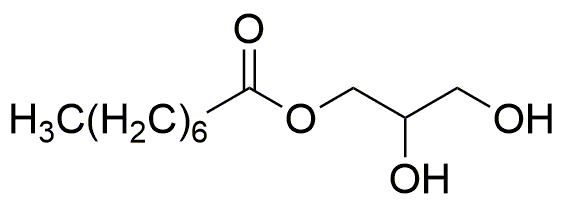Monocaprylin is widely utilized in research focused on:
- Food Industry: As an emulsifier and preservative, it enhances the texture and shelf life of various food products, making it ideal for baked goods and dairy items.
- Cosmetics and Personal Care: Its moisturizing properties make it a popular ingredient in creams and lotions, providing skin hydration and improving product stability.
- Pharmaceuticals: Used as a solubilizing agent for poorly soluble drugs, it helps improve bioavailability, allowing for more effective medication formulations.
- Animal Nutrition: Acts as a feed additive that promotes gut health and enhances nutrient absorption in livestock, contributing to better growth rates and overall health.
- Biotechnology: In cell culture applications, it serves as a surfactant that aids in the growth of cells, making it essential for research in tissue engineering and regenerative medicine.
Información general
Propiedades
Seguridad y normativas
Aplicaciones
Monocaprylin is widely utilized in research focused on:
- Food Industry: As an emulsifier and preservative, it enhances the texture and shelf life of various food products, making it ideal for baked goods and dairy items.
- Cosmetics and Personal Care: Its moisturizing properties make it a popular ingredient in creams and lotions, providing skin hydration and improving product stability.
- Pharmaceuticals: Used as a solubilizing agent for poorly soluble drugs, it helps improve bioavailability, allowing for more effective medication formulations.
- Animal Nutrition: Acts as a feed additive that promotes gut health and enhances nutrient absorption in livestock, contributing to better growth rates and overall health.
- Biotechnology: In cell culture applications, it serves as a surfactant that aids in the growth of cells, making it essential for research in tissue engineering and regenerative medicine.
Documentos
Hojas de datos de seguridad (HDS)
La SDS proporciona información de seguridad completa sobre la manipulación, el almacenamiento y la eliminación del producto.
Especificación del producto (PS)
La PS proporciona un desglose completo de las propiedades del producto, incluida la composición química, el estado físico, la pureza y los requisitos de almacenamiento. También detalla los rangos de calidad aceptables y las aplicaciones previstas del producto.
Certificados de análisis (COA)
Busque certificados de análisis (COA) ingresando el número de lote del producto. Los números de lote y de partida se pueden encontrar en la etiqueta de un producto después de las palabras "Lote" o "Lote".
Número de catálogo
Número de lote/lote
Certificados de origen (COO)
Este certificado de origen confirma el país en el que se fabricó el producto y también detalla los materiales y componentes utilizados en él y si se deriva de fuentes naturales, sintéticas u otras fuentes específicas. Este certificado puede ser necesario para cumplir con las normativas aduaneras, comerciales y regulatorias.
Número de catálogo
Número de lote/lote
Hojas de datos de seguridad (HDS)
La SDS proporciona información de seguridad completa sobre la manipulación, el almacenamiento y la eliminación del producto.
DownloadEspecificación del producto (PS)
La PS proporciona un desglose completo de las propiedades del producto, incluida la composición química, el estado físico, la pureza y los requisitos de almacenamiento. También detalla los rangos de calidad aceptables y las aplicaciones previstas del producto.
DownloadCertificados de análisis (COA)
Busque certificados de análisis (COA) ingresando el número de lote del producto. Los números de lote y de partida se pueden encontrar en la etiqueta de un producto después de las palabras "Lote" o "Lote".
Número de catálogo
Número de lote/lote
Certificados de origen (COO)
Este certificado de origen confirma el país en el que se fabricó el producto y también detalla los materiales y componentes utilizados en él y si se deriva de fuentes naturales, sintéticas u otras fuentes específicas. Este certificado puede ser necesario para cumplir con las normativas aduaneras, comerciales y regulatorias.

